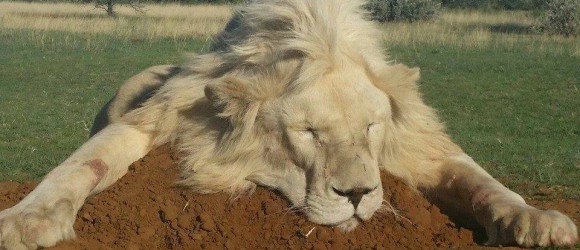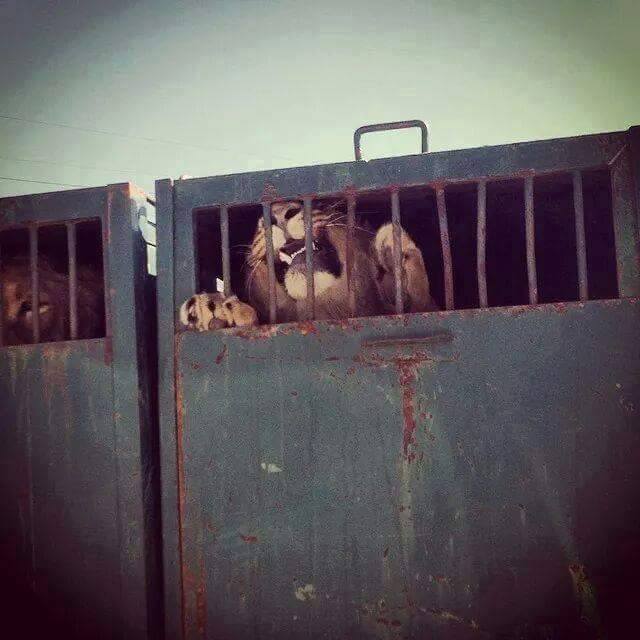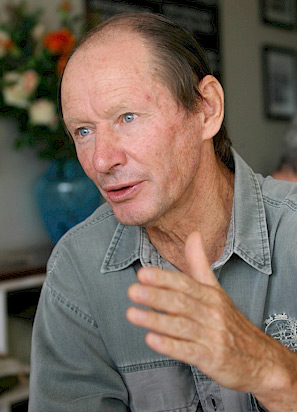Blood Lions
- At July 28, 2015
- By Rosemary Wright
- In Global Issues
 1
1

Blood Lions
A review (with no filter)
by Simon Bloch
The long awaited release of the film Blood Lions doesn’t just blow the lid off claims made by the predator breeding and canned lion-hunting industries – it effectively torpedoes them to another planet, and debunks all of their myths before your very own eyes, one at a time.
Guest Writer
Simon Bloch
Independent Journalist – Durban, South Africa
So revealing and honest is this film, I can guarantee it’s already rattled cages and opened closets full of skeletons, from Dallas to Reno, Shanghai to Little Saigon.
The premiere screening at the Durban International Film Festival more than lived up to the hype. It played to a packed house, and received a standing ovation.
A factual and brutally hard-hitting documentary filmed in HD, Blood Lions exposes South Africa’s “dirty little secret”, to a wider global audience via the big screen.
The pre-publicity and social media campaign around the movie has made Blood Lions the most talked about conversation on Facebook and twitter over the past few weeks – a much larger public are now aware of the con in conservation, and the trade in skin, bones, blood and money.
There are approximately 6000 captive lions on about 200 properties, according to government figures. The official South African government line is that they are monitoring them, but in all honesty, the departments are so fragmented, the left hand does not know what the right hand is doing, according to animal behaviour specialist and rehab expert, Karen Trendler.
The fair-chase principal does not exist on a canned-hunt. The outcome is guaranteed.
A canned hunt is where the target animal is unfairly prevented from escaping the hunter, either by physical constraints, such as fencing, or by mental constraints, such as being habituated to humans, according to Chris Mercer, director of the Campaign Against Canned Hunting (CACH).
Chris Mercer
Canned lion-hunt operators also draw on deception and other bags of tricks to guarantee the kill for wealthy clients. Hunting videos show how predators are lured into the hunters’ sights by bait-carcasses left hanging from trees. Or purposely-dropped pools of animal blood meant to attract the semi-tame cats within shooting range.
This is highly-charged and explosive proof of the psychopathic persecution of lions for hunting trophies, and not conservation.
The film’s executive producer Dr. Andre Venter, said after the screening: “This film comes as a call for action, and as a voice for the voiceless. We are part of the global movement that wants to put a stop to this abhorrent behaviour”.
The clear narrative and visuals from the documentary cast a dark shadow over South Africa’s environmental track-record and conservation ethos, leaving viewers asking how 21st century civilization has allowed such barbaric practices to flourish untouched for so long – and clearly conveys a message to the South African authorities, from millions of people around the world who have for years been shouting: “Shut them down and close the door”.
Blood Lions identifies a sleazy industry, camouflaged from the public’s prying eyes, and well-protected from outside inflitrators or “greenies”.
For veteran canned lion investigator, international campaigner and conservationist Ian Michler, “part of the narrative behind canned lions is brutality. I certainly believe this is a continuation of the story of South Africa’s brutal past”.
Senior provincial nature conservation official Werner Boing admits on camera: “It’s time we started to be honest with ourselves”.
Derek Hanekom, Minister of Tourism, even adds: My feeling is I’m not proud of it. The industry has certainly damaged Brand South Africa.”
Also interviewed is Botswana’s Environment minister, Tshekedi Khama, who says: “We don’t get second chances”.
Captive bred lions are human imprinted, bred with suspect, or inferior genes compared to the wild predators that have no equal. They can never be released to the wild, and therefore play no role in conserving the wild population.
The South Africa government owns the problem, “lock- stock and barrel”, having failed to stand up to powerful wildlife industry lobby groups, its own poor regulatory controls and the continually mis-construed definition of the term “sustainable use”.
Blood Lions argues that “sustainable use” been hi-jacked by BIG MONEY and the powerful hunting and pseudo-science research communities to suit their own agendae. Lawyers, guns and money have turned the reference term on its head, so that it has become “legally sustainable abuse”.
The film covers the unnatural cycle of life of canned lions, from the cradle to the grave, from the time they are hand-reared as two or three day-old cubs by overseas volunteers, to the day they are shot or wounded by foreign hunters, who often have no shooting and hunting skill, but spend thousands for the thrill of the kill. There is gut-wrenching footage of wounded predators unable to move.
Sometimes the mercy or kill-shot shot will take minutes, or hours to arrive.
At the centre of it all is the Big Con in Conservation, where thousands of international gap-year students pay millions to breeding-farm operators for opportunities to work with the lions and cubs, ‘con’-vinced they will be playing important roles in conserving the species.
They bottle-feed cubs at supposed “sanctuaries”, which are nothing more than battery farms and tourist traps. In essence, unscrupulous breeders and preying tourism-agents lure them into the traps by exploiting their naivety and compassion for animal welfare.
The dark under-belly of the beast is dissected and laid-bare in this well-crafted film, when an American named Rick travels to hunting farms in search of a canned hunt.
There are tense moments and candid, life threatening dramas involving stand-offs with hunting operators and members of the so-called Afrikaner “predator mafia”, which reminded me of the film Deliverance.
Caught off-guard by paranoid canned hunters, the film crew were forced on more than one occasion to beat a hasty retreat, or possibly “be fed to the lions”, after they were outed as “undercover spies”.
It’s a multi-million dollar industry and Blood Lions joins all the dots in the canned lion saga – bred for the bullet or bones at breeding farms and volunteer traps of the Free State to the heart of the Safari Club International organisation and its annual hunt-marketing shows in Reno, and back again to the killing-fields (canned-hunting farms) of Limpopo, the North West and the Eastern Cape.
Supported by an avalanche of public opinion, Blood Lions succeeds in showing the canned lion industry to be a man-made business venture that trades off nothing but a myth – African lions, the majestic king of all wild beasts, reduced to nothing but walking target-practice – bred for the bullet, and skinned for a trophy.
Furthermore, the film also explains how the canned-lion farmers pose a major threat to conservation of the last remaining wild lion populations left in Africa.
Breeders hire smugglers to shoot female pride-mothers in the wild and steal their cubs for breeding purposes. (for new blood-lines)
The lion bone trade started on hunting farms, and has had a devastating knock-on effect. It has become a flourishing business for taxidermists who export them to Asian traders to be mixed in expensive tonic wines as a replacement for tiger bones.
There are more than 1000 canned-lion hunts every year. Lion skeletons can fetch up to R18000, but the South African government allows the trade, again under the blanket of” sustainable use of natural resources”.
Tigers however, are listed on the IUCN’s red-list as a “most critically endangered” species, and although they may not be hunted in Asia, they are bred in captivity in China, Thailand and Vietnam specifically for the harvesting of their body parts.
Questionable is why tiger hunting on private farms in South Africa is legal.
Classified in South Africa as an exotic species, since they are not indigenous to the continent, there have been claims that tiger bones are hidden in shipments of lion bones exported to Laos and Vietnam.
That’s it in a nutshell – South Africa’s ridiculous notion that captive-bred lions are categorized as having economic value because they are a “valuable resource”, and therefore allowed to be bred for the bullet. Nothing more, and nothing less!
Abhorrent human behaviour at its worst, and a severe indictment on a country where people still care. (Note: lions are a living, sentient species)
In the the aftermath of the screening, the word is out that in the North West Province, the hunting community are scrambling to control the fallout.
The after-shock and tremors were also felt by the SCI hunting brotherhood, and a few of their huntresses – hello Kendall, hi Melissa – your camo clothing just went out of fashion.
Maybe the Kardashians can teach you something about reality shows, hey!
Or as the Donald (Trump) would say – “Your shelf-life just expired. You’re fired!”.
Meanwhile, conservation department officials who were supposed to monitor thousands of lion hunts, could soon find themselves out of work!
Kudos to the Blood Lions crew led by producer Pippa Hankinson, conservationist and story-teller Ian Michler, camerman/director Nick Chevalier, and executive producer Andrew Venter of Wildlands, for their brave endeavoor in making this film.
Blood Lions has been accepted at a further number of international film festivals around the world. A global distributor will soon be announced.
Rating ***** Excellent.
Only a day after seeing the film, President of the Professional Hunters Association of South Africa, Herman Meyeridricks, issued the following statement.
PHASA PRESIDENT CALLS FOR A REVIEW OF LION HUNTING
Pretoria, 24 July 2015 – Hermann Meyeridricks, president of the Professional Hunters’ Association of South Africa (PHASA), is asking the hunting association to reconsider its position on lion hunting.
In a letter emailed to PHASA members today, Meyeridricks says that the campaign against trophy hunting has intensified around the canned or captive-bred lion hunting issue since its current policy on lion hunting was adopted at its AGM in November 2013.
“We took the view that our position was a stepping-stone to clean up the captive-bred lion hunting industry and made it clear that it was certainly not our final word on the hunting of lions,” he says.
“From my dealings with the media and the community, it has become clear to me that those against the hunting of lions bred in captivity are no longer just a small if vociferous group of animal-rights activists. Broader society is no longer neutral on this question and the tide of public opinion is turning strongly against this form of hunting, however it is termed. Even within our own ranks, as well as in the hunting fraternity as a whole, respected voices are speaking out publicly against it.”
Meyeridricks says that with some airlines and shipping lines refusing to transport hunting trophies, PHASA has to face the fact that the lion issue is putting at risk not only the reputation of professional hunting in South Africa but its very survival.
“PHASA’s current policy on the issue is, broadly speaking, that it recognises the legality of and demand for captive-bred lion hunting, and is working with the predator breeders and government to improve its standards and conditions to a generally acceptable level. We have made little demonstrable progress on this front,” he says.
“Against this background, I have come to believe that, as it stands, our position on lion hunting is no longer tenable. The matter will be on the agenda again for our next annual general meeting and I appeal to you to give it your serious consideration, so that together we can deliver a policy that is defensible in the court of public opinion,” he says in the letter.
It sounds like PHASA is juggling their options. An overwhelming majority of their members support captive-bred lion hunting.
Not to be tarred-and-feathered with the same brush, a minority group of PHASA members, SAMPEO, have for years been at odds with their own members.
In a damning statement “STANCE ON CAPTIVE BRED / CANNED LION HUNTING”, SAMPEO state: “We, long standing hunting outfitters, wish to express our opposition to the hunting of canned and captive bred lions”
“We are further aware that there are other outfitters who, like us, condemn this practice.
As hunting outfitters and professional hunters, we unanimously and unequivocally;
1. Condemn the immoral practice of canned/captive bred lion shooting, where lions are bred for the SOLE purpose of being killed by paying clients and play no meaningful contribution to wildlife conservation, financial or otherwise that aids the species the African Lion (panthera leo) in its natural state.
2. See no meaningful distinction between the terms “canned” or “captive bred” lion hunting, in its current format, as in the accepted SAPA document.
3. Believe that the shooting of lion, bred and raised in breeding facilities and subsequently released for a period of 7 days in accordance with the current SAPA norms and standards, prior to the shoot commencing, is reprehensible.
4. Do not believe that the SAPA norms and standards for the shooting of canned/captive bred lions can be considered fair chase hunting. Where the animal is self-sustaining, can feed naturally, breed naturally and has a chance of evading the hunter. None of these criteria are met.
5. Do not believe the practice can be effectively policed and monitored and to date has been rocked by one scandal after another.
6. We believe the practice is degrading to the African Lion, which is an iconic and regal symbol of all African wildlife. The activities of a few have severely tarnished the reputation of our industry. They have caused major harm to those of us whom are committed to acceptable hunting practices that enhance the already significant conservation efforts that have been and are made by hunting in South Africa.




Follow – A BEATING HEART